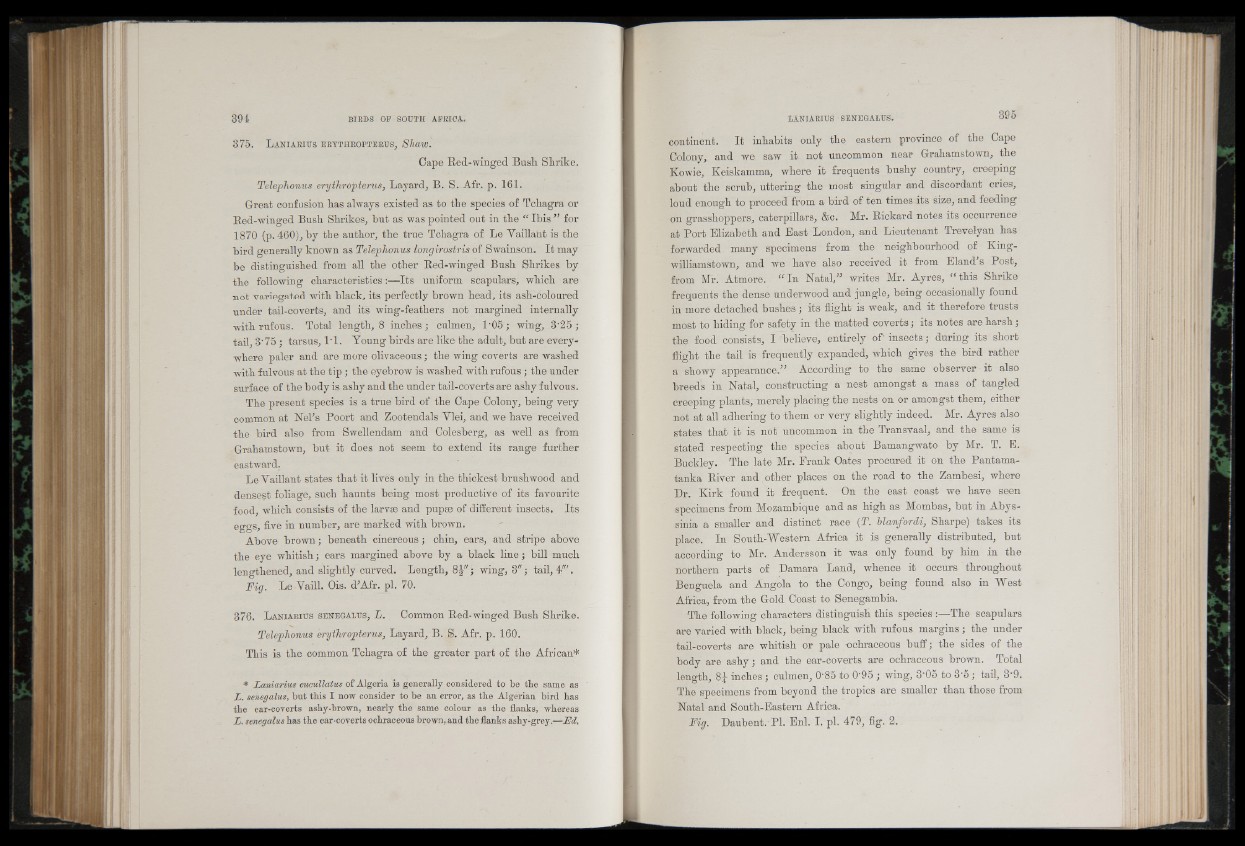
375. L a n i a r i u s e r y t h r o p t e r u s , Shaw.
Cape Red-winged Busli Shrike.
Telephonus erythropterus, Layard, B. S. Afr. p. 161.
Great confusion has always existed as to the species of Tchagra or
Red-winged Bush Shrikes, but as was pointed out in the “ Ibis ” for
1870 (p. 460), by the author, the true Tchagra of Le Vailla'nt is the
bird generally known as Telephonus longirostris of Swainson. It may
be distinguished from all the other Red-winged Bush Shrikes by
the following characteristics:—Its uniform scapulars, which are
not variegated with black, its perfectly brown head, its ash-coloured
under tail-coverts, and its wing-feathers not margined internally
with rufous. Total length, 8 inches ; culmen, 1'05; wing, 3'25 ;
tail, 3‘75 ; tarsus, T l. Young birds are like the adult, but are everywhere
paler and are more olivaceous; the wing coverts are washed
with fulvous at the tip ; the eyebrow is washed with rufous ; the under
surface of the body is ashy and the under tail-coverts are ashy fulvous.
The present species is a true bird of the Cape Colony, being very
common at Nel’s Poort and Zootendals Ylei, and we have received
the bird also from Swellendam and Colesberg, as well as from
Graham stown, but it does not seem to extend its range further
eastward.
Le Vaillant states that it lives only in the thickest brushwood and
densest foliage, such haunts being most productive of its favourite
food, which consists of the larvae and pupae of different insects. Its
eggs, five in number, are marked with brown.
Above brown; beneath cinereous; chin, ears, and stripe above
the eye whitish; ears margined above by a black line; bill much
lengthened, and slightly curved. Length, 8 J"; wing, 3"; tail, 4"'.
Fig. Le Yaill. Ois. d’Afr. pi. 70.
376. L a n i a r i u s s e n e g a l u s , L. Common Red-winged Bush Shrike.
Telephonus erythropterus, Layard, B. S. Afr. p. 160.
This is the common Tchagra of the greater part of the African*
* Laniarius cucullatus of Algeria is generally considered to be tlie same as
L. senegalus, but this I now consider to be an error, as the Algerian bird has
the ear-coverts ashy-brown, nearly the same colour as the flanks, whereas
L. senegalus has the ear-coverts ochraceous brown, and the flanks ashy-grey.—Ed.
continent. It inhabits only the eastern province of the Cape
Colony, and we saw it not uncommon near Grahamstown, the
Kowie, Keiskamma, where it frequents bushy country, creeping
about the scrub, uttering the most singular and discordant cries,
loud enough to proceed from a bird of ten times its size, and feeding
on grasshoppers, caterpillars, &c. Mr. Rickard notes its occurrence
at Port Elizabeth and East London, and Lieutenant Trevelyan has
forwarded many specimens from the neighbourhood of King-
williamstown, and we have also received it from Eland s Post,
from Mr. Atmore. “ In Natal/’ writes Mr. Ayres, “ this Shrike
frequents the dense underwood and jungle, being occasionally found
in more detached bushes ; its flight is weak, and it therefore trusts
most to hiding for safety in the matted coverts; its notes are harsh;
the food consists, I believe, entirely of’ insects; during its short
flight the tail is frequently expanded, which gives the bird rather
a showy appearance.” According to the same observer it also
breeds in Natal, constructing a nest amongst a mass of tangled
creeping plants/merely placing the nests on or amongst them, either
not at all adhering to them or very slightly indeed. Mr. Ayres also
states that it is not uncommon in the Transvaal, and the same is
stated respecting the species about Bamangwato by Mr. T. E.
Buckley. The late Mr. Prank Oates procured it on the Pantama-
tanka River and other places on the road to the Zambesi, where
Dr. Kirk found it frequent. On the east coast we have seen
specimens from Mozambique and as high as Mombas, but in Abyssinia
a smaller and distinct race (T. blanfordi, Sharpe) takes its
place. In South-Western Africa it is generally distributed, but
according to Mr. Andersson it was only found by him in the
northern parts of Damara Land, whence it occurs throughout
Benguela and Angola to the Congo, being found also in West
Africa, from the Gold Coast to Senegambia.
The following characters distinguish this species :—The scapulars
are varied with black, being black with rufous margins; the under
tail-coverts are whitish or pale -ochraceous buff; the sides of the
body are ashy; and the ear-coverts are ochraceous brown. Total
length, 8£ inches; culmen, 0-85 to 0'95 ; wing, 3'0o to 3‘5 ; tail, 3'9.
The specimens from beyond the tropics are smaller than those from
Natal and South-Eastern Africa.
Fig. Daubent. Pl. Enl. I. pi. 479, fig. 2.